Vatican Art Story | Location | Opening Hours Tickets | Authorisations
Art Story Sistine Chapel | Raphael | Caravaggio | da Vinci | Giotto | Titian | Veronese | Sculptures | Van Gogh |
Vincent Van Gogh “Pietà” after Eugène Delacroix at the Vatican Museum of Contemporary Art in Rome
Vincent Van Gogh (1853-1890) “Pietà” after Delacroix
Painting - Oil on Canvas (41.5 x 34 cm) 1890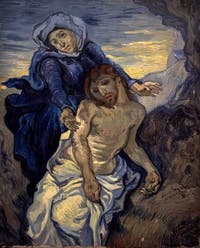
Van Gogh “Pietà” The “Pietà” that Vincent Van Gogh made from a lithograph of the same subject painted by Delacroix has a very particular story.
First, it is the only representation of Christ that can be found in all of Van Gogh’s work.
Although born to a father, Pasteur and having tried to become one, he failed theological exams and abandoned his ecclesiastical career.
It is, therefore, surprising that this “Pietà” is unique in Van Gogh’s work, which includes more than two thousand drawings and canvases.
Van Gogh became aware of Delacroix’s “Pietà” by reading a description of his painting:
“The chapel where I painted my “Pietà” was so dark that I didn’t know how to paint my picture.
I was then forced to paint shadows in the corpse of Christ with Prussian blue, the lights with pure chrome yellow.”
Eugène Delacroix
A description could be that of a Van Gogh painting, Prussian blue and chrome yellow, of colours that he likes, which he uses to intensify the contrasts, shadows and lights of his canvases.
Van Gogh admired Delacroix, saying:
“that he had a sun in his head and a storm in his heart.”
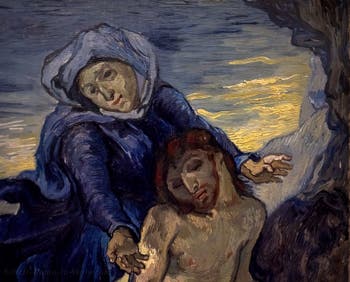
Van Gogh “Pietà” Vincent Van Gogh would never see the work painted by Delacroix, but his brother Théo, at his request, would provide him with a lithograph.
Van Gogh's “Pietà”, a fortuitous event
Van Gogh did not intend to paint a pietà, but a fortuitous event prompted him to make his own pietà according to Eugène Delacroix:“So this time, a misfortune happened to me during my illness. This lithograph by Delacroix, La Pietà, with other leaves, had fallen into oil and paint and had been damaged.
I was sad about it, so I got busy painting it, and you’ll see that one day, on a canvas of 5 or 6, I made a copy that I think is well worth it.”
Vincent Van Gogh’s letter to his brother Theo dated September 10, 1889
In another letter to his sister Willemien, Vincent Van Gogh said that the Virgin Mary of the “Pietà” by Delacroix reminded him of the novel by Jules and Edmond de Goncourt, Germaine Lacerteux (1865), in which an old maid, crazy with love, becomes hysterical and alcoholic.
After the lithography accident, Van Gogh painted the first version for his brother Theo.
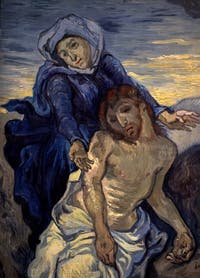
Van Gogh “Pietà” Then in 1890, a few weeks before his death, Van Gogh made another version of the “Pietà” in Auvers-Sur-Oise, this time for his sister Willemina.
A version with smaller dimensions, 41.5 x 34 cm, but much more powerful.
You can admire this version today at the Vatican Museum of Contemporary Art, which is located just after the Borgia apartments.
Van Gogh's “Pietà”: a “Mater Dolorosa”
This Van Gogh “Pietà” well conveys all of Our Lady’s pain with her hands that express despair and incomprehension, hands that she extends to each side of the body of Christ in the act of powerlessness.Van Gogh paints her face as if she were as deprived of life as her son. Her complexion was paler than her son’s.
In this “Pietà” by Van Gogh, the face of the Madonna is like a mirror, like a replica of the face of Christ, with the same inclination of the head and the same expression absent.
The only difference between them is in their looks.
Of course, Christ has his eyes closed while Mary looks lost, the gaze of someone who is no longer there, who is no longer with us.
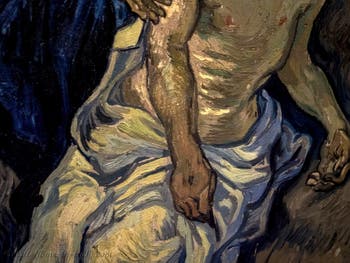
Van Gogh “Pietà” She does not look at her son, she does not beg for heaven, and her face is turned towards the outside of the painting.
We don’t even know if his eyes can still see anything.
Van Gogh, in fact, accentuated the absence of his eyes by painting two dark, empty eye sockets.
Only the barely coloured lips of the Virgin still suggest a pretence of life in her prostrate body where the only speck of life is that of her garments fluttering in the wind.
We know from a letter to his brother that Van Gogh painted his “Pietà” under such violent bursts of mistral that he had to hang his easel on a rock.
A picture that he, therefore, painted outside, in extreme conditions to even better feel the desolate effect of the scene himself.
Van Gogh wrote to his brother:
“Christ lies at the cave entrance, his hands forward... the face is in the shadows, the woman’s pale face is clearly cut out on a cloud.”
Vincent Van Gogh’s letter to his brother Theo dated September 10, 1889
This desolate, rocky, windy landscape, without any trace of plant life, located at the entrance of the Sepulchre Cave, adds to the despair and despair of the Virgin.
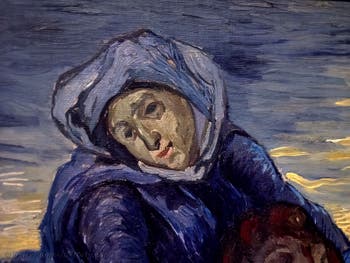
Van Gogh “Pietà” The only touches of light are in the sky, a typical Van Gogh sky streaked with large yellow splashes undulating on the horizon.
In contrast to the rest of the painting, Christ is represented with a peaceful attitude. The pain he has endured has left him. He simply seems asleep.
Premonition of the Resurrection?
In any case, this is our interpretation when we see that Van Gogh reproduced these same touches of yellow on the shroud of Christ: the light that comes after darkness.Van Gogh and the Christ Artist
Although Van Gogh left us with only one representation of Christ in all of his work, his religious vocation permeated his life, and his reflections on Christ that can be read in his correspondence to his friend Émile Bernard are particularly profound.A particular Christ, a la Van Gogh, a Christ whom he defines as an artist:
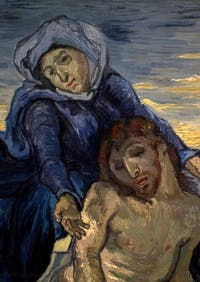
Van Gogh “Pietà”
“The Bible is Christ because the Old Testament tends to this summit. Saint Paul and the Evangelists occupy the other slope of the sacred mountain. [...]
But the consolation of this very sad Bible, which arouses our despair and indignation, heartbreaks us for good, all outraged by its smallness and contagious madness, the consolation it contains, like a core in a hard shell, a bitter pulp, is Christ. [...]
Among all philosophers and magicians, Christ alone affirmed eternal life, the infinity of time, the absence of death, and the necessity and purpose of serenity and devotion as the central certainty.
He lived peacefully as an artist more remarkable than any artist, disdaining marble, clay, and colour and working in living flesh.
This incredible artist, barely conceivable with the obtuse instrument of our nervous and stupid modern brains, did not make statues, paintings or even books... he says it loud, he made... living men, immortals.”
Vincent Van Gogh, Letter to Émile Bernard June 1888
Art Story Sistine Chapel | Raphael | Caravaggio | da Vinci | Giotto | Titian | Veronese | Sculptures | Van Gogh |
Vatican Art Story | Location | Opening Hours Tickets | Authorisations
Back to Top of Page

